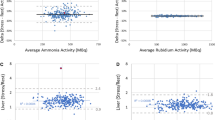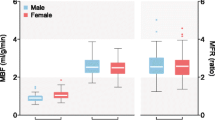Abstract
Background
Short imaging protocol to quantify myocardial blood flow (MBF) and myocardial flow reserve (MFR) may enhance the clinical application of 13N-ammonia cardiac PET. We assessed the flow quantitation of 13N-ammonia PET implementing simple retention model and two-compartment model.
Methods
Fourteen healthy volunteers (HVT) and twenty-three clinical patients received 13N-ammonia PET/CT. The simple retention model used the first 7-minute image to quantify MBF. Global and regional MBF and MFR of the two models were compared.
Results
Global and regional MBF and MFR of these two models were highly correlated with mildly inferior correlation in RCA territory (global R2: rest MBF = 0.79, stress MBF = 0.65, MFR = 0.77; regional R2: rest MBF ≥ 0.72, stress MBF ≥ 0.52, MFR ≥ 0.68). There were significant differences for MFR (4.04 ± 0.72, 3.66 ± 0.48, p = .02) and rest MBF (0.69 ± 0.12, 0.78 ± 0.12, p = .02) between the two models in the HVT group.
Conclusions
13N-ammonia global and regional MBF and MFR from the simple retention model demonstrate strong correlations with that from the two-compartment model. Significant differences of MFR and rest MBF are noted in the HVT group, with a proposed normal reference value for the 13N-ammonia short simple retention protocol.




Similar content being viewed by others
Abbreviations
- AI:
-
Arterial input
- AIF:
-
Arterial input function
- CI:
-
Confidence interval
- HVT:
-
Healthy volunteers
- IDAI:
-
Image-derived arterial input
- LoA:
-
Limits of agreement
- MBF:
-
Myocardial blood flow
- MFR:
-
Myocardial flow reserve
- PS:
-
Permeability-surface area
- TAC:
-
Time-activity curve
References
Murthy VL, Bateman TM, Beanlands RS, Berman DS, Borges-Neto S, Chareonthaitawee P, et al. Clinical quantification of myocardial blood flow using PET: Joint position paper of the SNMMI Cardiovascular Council and the ASNC. J Nucl Cardiol 2018;25:269-97.
Murthy VL, Naya M, Foster CR, Hainer J, Gaber M, Di Carli G, et al. Improved cardiac risk assessment with noninvasive measures of coronary flow reserve. Circulation 2011;124:2215-24.
Gould KL, Johnson NP, Bateman TM, Beanlands RS, Bengel FM, Bober R, et al. Anatomic versus physiologic assessment of coronary artery disease. Role of coronary flow reserve, fractional flow reserve, and positron emission tomography imaging in revascularization decision-making. J Am Coll Cardiol 2013;62:1639-53.
Johnson NP, Gould KL. Integrating noninvasive absolute flow, coronary flow reserve, and ischemic thresholds into a comprehensive map of physiological severity. JACC Cardiovasc Imaging 2012;5:430-40.
Tahari AK, Lee A, Rajaram M, Fukushima K, Lodge MA, Lee BC, et al. Absolute myocardial flow quantification with (82)Rb PET/CT: Comparison of different software packages and methods. Eur J Nucl Med Mol Imaging 2014;41:126-35.
Nesterov SV, Deshayes E, Sciagra R, Settimo L, Declerk JM, Pan XB, et al. Quantification of myocardial blood flow in absolute terms using (82)Rb PET imaging: The RUBY-10 Study. JACC Cardiovasc Imaging 2014;7:1119-27.
Johnson NP, Gould KL. Physiological basis for angina and ST-segment change PET-verified thresholds of quantitative stress myocardial perfusion and coronary flow reserve. JACC Cardiovasc Imaging 2011;4:990-8.
Hsu B, Hu LH, Yang BH, Chen LC, Chen YK, Ting CH, et al. SPECT myocardial blood flow quantitation toward clinical use: A comparative study with 13N-Ammonia PET myocardial blood flow quantitation. Eur J Nucl Med Mol Imaging 2017;44:117-28.
Yoshida K, Mullani N, Gould KL. Coronary flow and flow reserve by PET simplified for clinical applications using rubidium-82 or nitrogen-13-ammonia. J Nucl Med. 1996;37:1701-12.
Murthy VL, Lee BC, Sitek A, Naya M, Moody J, Polavarapu V, et al. Comparison and prognostic validation of multiple methods of quantification of myocardial blood flow with 82Rb PET. J Nucl Med 2014;55:1952-8.
Vasquez AF, Johnson NP, Gould KL. Variation in quantitative myocardial perfusion due to arterial input selection. JACC Cardiovasc Imaging 2013;6:559-68.
Beanlands RS, deKemp R, Scheffel A, Nahmias C, Garnett ES, Goates G, et al. Can nitrogen-13 ammonia kinetic modeling define myocardial viability independent of fluorine-18 fluorodeoxyglucose? JACC. 1997;29:537-43.
Renaud JM, DaSilva JN, Beanlands RS, DeKemp RA. Characterizing the normal range of myocardial blood flow with 82rubidium and 13N-ammonia PET imaging. J Nucl Cardiol 2013;20:578-91.
Slomka PJ, Alexanderson E, Jacome R, Jimenez M, Romero E, Meave A, et al. Comparison of clinical tools for measurements of regional stress and rest myocardial blood flow assessed with 13N-ammonia PET/CT. J Nucl Med 2012;53:171-81.
Acknowledgements
We thank Tinsu Pan, PhD, Liang-Chih Wu, PhD, and Nien-Yun Wu, MS, for their technical assistance in performing the cardiac PET analysis. Professor Ren-Shyan Liu was supported by the Ministry of Science and Technology of Taiwan (MOST 105-2314-B-010-034-MY2; MOST 107-NU-E-010-002-NU), and supported by the Department of Health (MOHW107-TDU-B-211-114019).
Disclosure
All authors declare that they have no conflict of interest.
Author information
Authors and Affiliations
Corresponding author
Additional information
The authors of this article have provided a PowerPoint file, available for download at SpringerLink, which summarises the contents of the paper and is free for re-use at meetings and presentations. Search for the article DOI on SpringerLink.com.
Electronic supplementary material
Below is the link to the electronic supplementary material.
Rights and permissions
About this article
Cite this article
Chang, CY., Hung, GU., Hsu, B. et al. Simplified quantification of 13N-ammonia PET myocardial blood flow: A comparative study with the standard compartment model to facilitate clinical use. J. Nucl. Cardiol. 27, 819–828 (2020). https://doi.org/10.1007/s12350-018-1450-1
Received:
Accepted:
Published:
Issue Date:
DOI: https://doi.org/10.1007/s12350-018-1450-1




